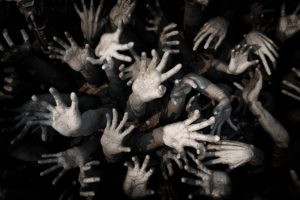
Zombies are a large part of popular culture in the United States. They’re everywhere in television, film, literature and video games, and have served as inspiration for zombie walks. These beings remain an ever-present source of fascination, awe, terror and even humor. However, the origins of their myths lie in religious beliefs that are still poorly understood by outsiders.
Roots in African and Haitian Folklore
In an article in The Atlantic from 2015, writer Mike Mariani detailed the zombie’s genesis in Haitian folklore and religious traditions. Slaves in Haiti from the 17th through the 19th centuries believed that upon death, their souls would be released to stay in a paradise called lan guinée, which was another name for Guinea or West Africa. Newly departed souls would be escorted to this realm by Baron Samedi, a Voodoo loa whose purpose was to dig the graves of the newly departed and welcome them into the afterlife.
Unfortunately, these traditions also held that those who committed suicide were not permitted to enter lan guinée. Instead, they were condemned to roam the islands and plantations for eternity while trapped in their own decaying bodies, only able to escape if they consumed salt. Some have suggested that these stories of physically walking dead may have their roots in South African legends of creatures called “xidachane.” Writer Amy Wilentz of the New York Times also proposed that these myths could have been partially fueled by slave owners themselves, who had plenty of incentive to prevent slaves from taking their own lives to escape the horrible conditions in the island’s plantations and fields.
Truth in the Myths?
In the late 1930s, African-American writer Zora Neale Hurston tried to uncover the mystery behind zombies as part of her exploration of Haitian culture. She encountered a woman in a village on the island, who claimed to have died and been interred nearly 30 years prior to Hurston’s visit. Nevertheless, medical evidence revealed that she did not possess a telltale leg fracture that the deceased woman had suffered. Meanwhile, Hurston pursued local rumors that powerful psychoactive drugs may have caused individuals to enter trances, rendering them mute and acting like the zombies of folklore. She wrote of her investigations in her book “Dust Tracks on a Road,” concluding that any pharmaceutical causes for zombie-like behavior had yet to be discovered.
Some versions of these tales hold that a bokor, or sorcerer, can turn a living individual into a zombie through a powerful cocktail of drugs. Said to contain poison extracted from puffer fishes, locals believed that these potions could make person appear as if he or she was dead. After dosing the individual, the bokor supposedly keeps him or her in this state with a steady diet of strong drugs, producing a mind-control effect and placing him or her under the bokor’s command. British writer Neil Gaiman makes a brief reference to this version of the legend in his 1989 paperback comic collection “The Sandman: Preludes & Nocturnes.” Daniel Bustamonte is a Jamaican man rumored by the local scuttlebutt to be a zombie poisoned by black magic. However, he is a sufferer of a sleeping sickness affecting humans worldwide in Gaiman’s narrative.
From Religion to Pop Culture
In American pop culture, zombies’ roots can be traced back to comic books such as “Tales from the Crypt” and horror films such as “Night of the Living Dead.” The genre has also given rise to a trope known as the “zombie apocalypse” in which civilized society breaks down under a seemingly inhuman invasion. Reimaged in other franchises such as the Borg of the Star Trek universe and darkspawn in the Dragon Age video games, the religious origins of these legendary beings are sometimes forgotten as they amble through our human imaginations.

